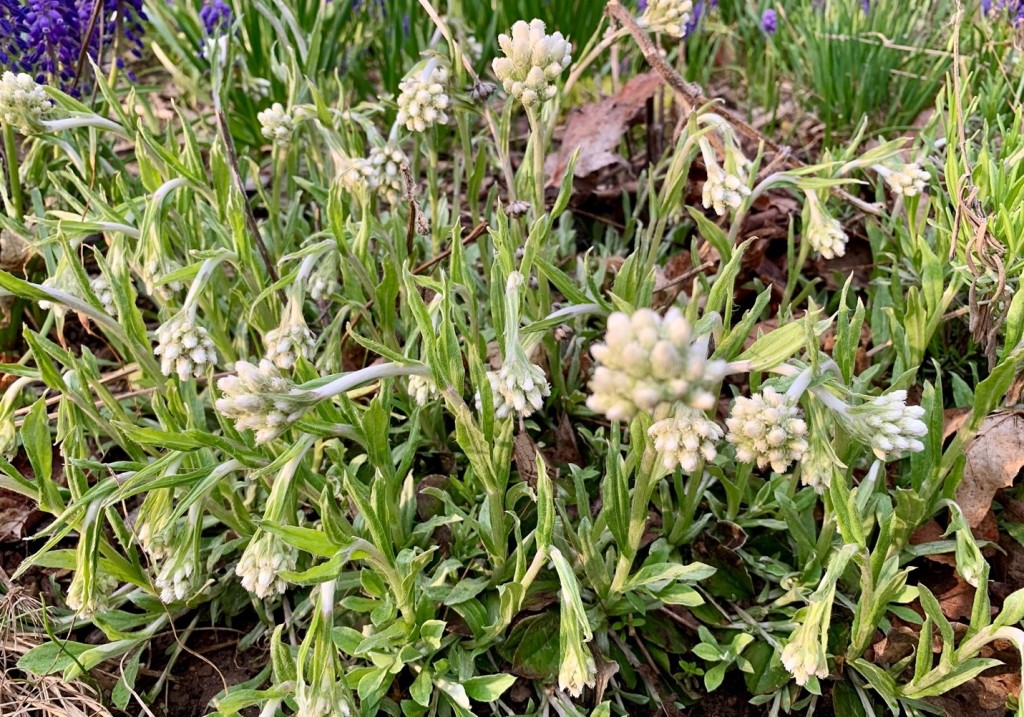By Lois Scott, Master Gardener
After reclaiming the full width of a garden path, I realized I needed to deal with the erosion of soil from the adjacent garden area. Erosion is a problem for me in a few other areas such as the public sidewalk which has garden sloping down to it. Not only soil goes sliding but after a heavy rain I find myself in the neighbour’s driveway apron sweeping up my mulch.
So, I have two goals. The first goal is the need for additional plants to better hold the soil and the second goal is for these plants to be a green mulch reducing the need for wood mulch in these sloped areas. MG Laura Gardner discusses the idea of green mulch in her blog from May 2023 https://peterboroughmastergardeners.com/2023/05/08/mulling-about-mulches/ . In Laura’s blog, green mulch is described by Benjamin Vogt as being a lower plant layer that covers 90% of the ground. To meet my first goal, I need to expand my plantings of fibrous rooted plants. Fibrous roots are the opposite of tap roots (like a carrot) and are most effective at binding the soil. When looking for fibrous rooted plants good choices are native grasses, native sedges (Carex), and most colonizing native wild flowers. For this blog I am referring to herbaceous plants but there are many native shrubs and trees that are excellent at preventing erosion. https://watersheds.ca/how-native-plants-help-with-erosion-control/
Some parts of these sloped areas are working well for me with plant material effectively holding soil and effectively mulching the soil. For other areas I need denser plantings for both sunny and dry, semi-shade and moist. Prairie Smoke (Geum triflorum) and Pussytoes (Antennaria neglecta) are two favourite native plants I have that may get used together in a spot that is sunny and dry. I am expanding my use of the native grass Prairie Dropseed (Sporobolus heterolepsis) along the sidewalk and a sedge (Carex), yet to be chosen, will underplant my Culver’s Root (Veronicastrum virginicum). Wild Ginger (Asarum canadense) and Foamflower (Tiarella stolonifera) will be expanded to cover and hold soil in a shadier, moist area. These native plant choices will all work to hold the soil and act as a green mulch.

If you are interested in learning more about how to stabilize a slope, please check out this post from the Halton Master Gardeners. https://haltonmastergardeners.com/2021/12/18/stabilizing-slopes/


Just adding an additional consideration to you, and those, who are trying to accomodate slope-side with or without plantings. I’m taking the inspiration for this comment from a neighbor who employed an approach I rarely see people using; and which has worked outstandingly to prevent slope slippage.
His yard is fronted by a sharp incline. He created a basic grid system comprised of 5 cm thick x several meters long slats of wood running vertically from the bottom of the slope to the top. Same dimension slats are affixed horizontally to create a grid. The quadrants of the grid are highly flexible. His are approximately 30 cm. square.
I don’t know if his grid is fixed firmly to the ground of the slope. As it runs top to bottom, it isn’t going anywhere. Atop the entire grid structure is a layer of wood chip mulch which hides the whole thing from view,
No slippage of the mulch or soil. slope secure. Plantings at the very top. This approach is highly adjustable to nearly every situation.
LikeLike